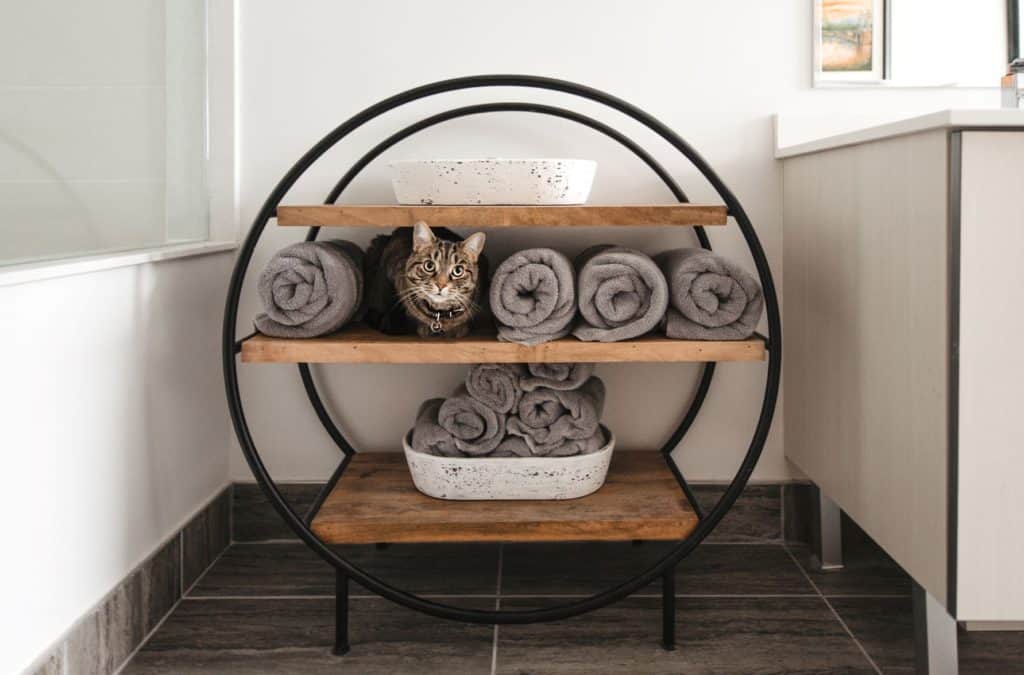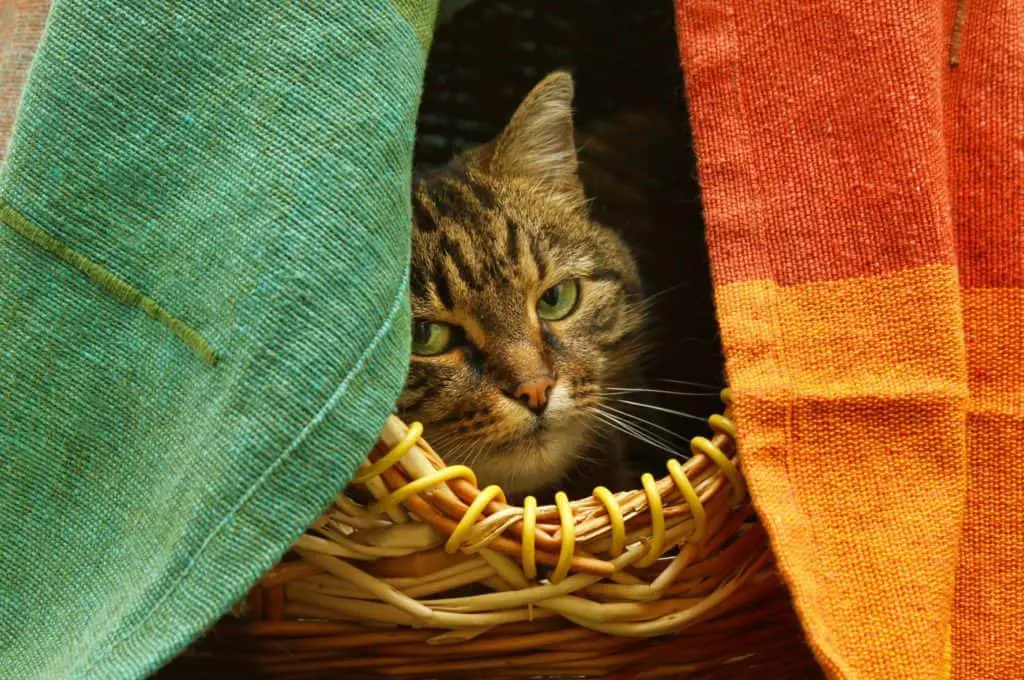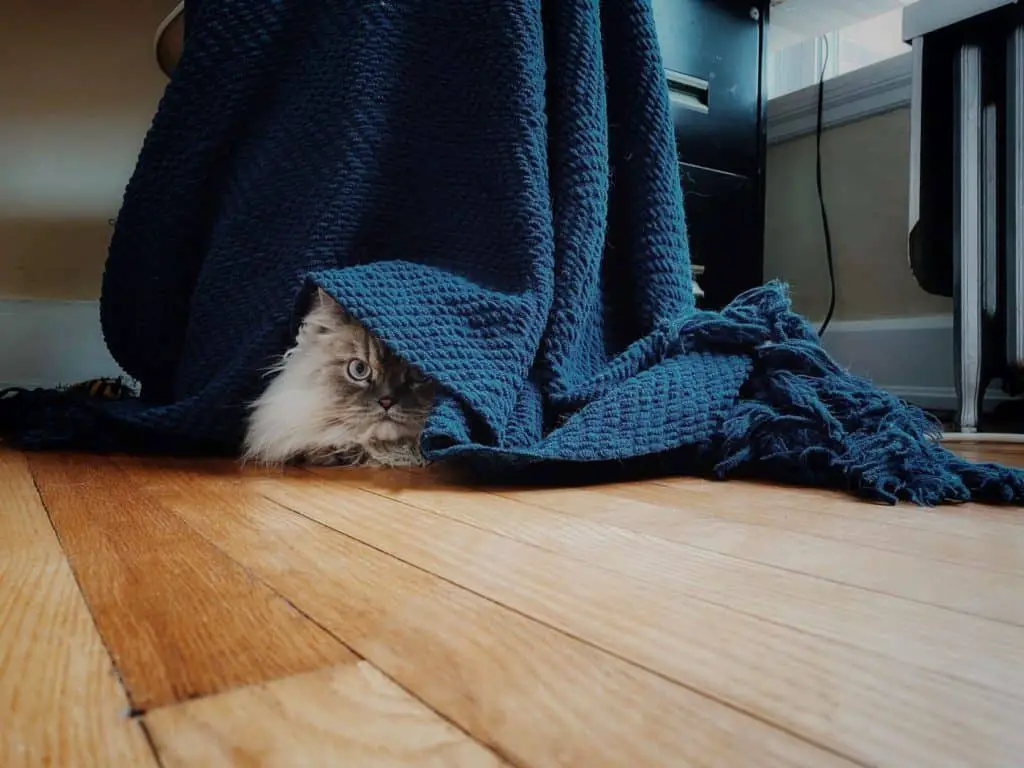Is your cat not eating and hiding? First, if it is a newly adopted kitten or cat, make sure they have easy access to resources. Give the cat 24 hours to adapt to their situation and make sure to track their progress and behaviors. If it is your resident cat, waiting 12-24 hours is a good guideline as well. Fear and stress can subside quite quickly, while illness and disease will have more prolonged effects.

If, after 24 hours, your cat is still hiding and hasn’t made any effort to eat or drink – they’re likely ill, and you should make a vet appointment. Make sure to track their progress carefully through video or photos to make sure you get the complete picture of what is going on.
Investigating Your Cat’s Issues: Checklist
There is, of course, a myriad of reasons why your cat has taken to hiding and is avoiding eating their food. Much like humans, reasons for a cat refusing to eat will be related to stress, anxiety, fear, or illness. In addition, cats are creatures of habit, and thus any disruption to their habitat or routine can discombobulate a cat and cause them to lose their appetites.
The are a few things to ask yourself if you notice your cat is hiding and not eating:
- Have there been any changes or disruption to the cat’s routine?
- Have I changed to different cat food?
- Events, situations, or even smells that were out of the ordinary?
- Have there been new or strange people in the house recently?
One important thing to note is that fear and stress can subside, but illness will stick around for much longer. Of course, there can be a lot of overlap between stress and disease. Therefore, careful examination of your cat’s physical as well as behavioral changes is required! Differentiating between the two is crucial to your cat’s health and wellbeing.
| Cat Fear/Stress | Cat Illness/Chronic Pain |
|---|---|
| It can last a short time to a moderately long time (1-24 hours). | Cats can exhibit prolonged distressed behaviors (24 hours to days). |
| Ovegrooming or decreased grooming. | Decreased grooming, disheveled look. |
| Decreased mobility, hiding in dark or small places. | Higher chance of inappropriate elimination depending on the illness/pain. |
What To Do If Your Cat Refuses to Eat or Drink?
Here are some easy steps you can take if your cat refuses to eat or drink to speed up its adaptation process:
- Set up the enviroment so there’s higher vantage points.
- Minimize large dark places that cats can hide under. Provide them with more cat centric furniture!
- Create easy access to food and water (don’t make them go up stairs or into other rooms).
- Use a pet camera or take a photo of the food and water to make sure that you aren’t missing any details (usually cats eat and drink when they feel most secure, usually when you’re asleep).
- Keep an exact timer of how long they are hiding. First, it gives useful information for the vet if you need to go. Second, getting an accurate view of how much time has past will allow owners to better gauge how their cat is doing. This is because owners will feel like time is going faster or slower during these situations.

How Long Can a Cat Hide and Not Eat?
Cats can survive up to 2 weeks without eating but only three days without water. Of course, waiting that long can cause a lot of other issues that can be prevented. Also, a lack of nutrition and protein will cause them to become progressively weaker.
When Should I Be Worried and Take My Cat to The Vet?
If this behavior is prolonged, 24+ hours, take them to a vet. It is always best to err on the side of caution with these things, as it could be an indicator of a more serious underlying health condition. When a cat refuses to eat, it should send a few alarm bells ringing as it is not typical cat behavior.
The best advice is to book a checkup with your local veterinarian, who will be able to run a series of tests and ask questions to determine and diagnose the cat’s condition. This is something that is best done sooner rather than later.

When a cat stops eating, they then have to rely on fat reserves for energy. Stored fats can be used as an energy source, but the liver must process them. This process requires extra protein, which if a cat is not eating, they will not have.
Continued refusal to eat will mean that the protein supplies eventually become exhausted and the liver filled with fat. This is a condition known as hepatic lipidosis, and it can lead to liver failure.
Common Reasons Why a Cat Wants to Hide & Not Eating
As previously touched upon, the most common reasons a cat doesn’t eat will be related to stress, anxiety, illness, or disruption to routine. If you notice that your cat has been hiding for some time and has not touched its food, it might be related to pain or illness.
Another reason for your cat not eating might be down to your behavior and habits. It’s important to remember how sensitive cats can be and that just like humans, they also feel stress and anxiety. So, for example, if you get home from work later than usual or if you have friends come over, these can cause stress in your cat and causes them to go into hiding.
These are some of the most typical reasons why a cat wants to hide and not eat:
- Sometimes, changes such as having a guest over to stay, new pet food, or even a recent trip to the vets can all disrupt your cat’s inner calm.
- Another reason why your cat doesn’t want to eat its food is that the food is not to your cat’s liking. That’s right! Your cat is telling you that you are not a connoisseur of cat food. Don’t take it personally. A good option is to buy a variety of different cat foods and see how they react to them!
- A newly adopted cat or kitten will require some time to feel secure in their environment. Therefore, it’s common for them to not eat and drink for a bit until they feel comfortable.
- Loud noises, accidents, or suprising situations can cause a fright in which they will need some time to get out of their funk.
- Spotting or smelling another foreign cat or animal in their territory can also cause cats to hide and not eat.
- And of course, pain and illness.
Cats are not particularly vocal about expressing pain when ill, making it hard to diagnose a problem. If you feel concerned, the best option will be to take your cat to the vet for a checkup.
Why Is My Newly Adopted Cat Hiding From Me?
It is very common for cats brought into a new home to hide, whether adopted or kittens. It is a natural reaction for cats to hide in new and unfamiliar surroundings. When a cat is uncertain, they will retreat to a place where they feel safe.
Don’t worry if you have moved home and your cat is nowhere to be seen. Cats are creatures of habit, and anything that forces them into the unknown will cause them to retreat and hide. They are trying to adjust to their new surroundings and build up a level of reassurance.
Try to talk and soothe your cat if you notice they are stressed and not eating but don’t force them into new rooms or places. Let them take their own sweet time. For more information about how to speed up and facilitate your cat’s adjustment time to their new home, here’s a guide!

This may be a place that’s hard for other animals and people to get to. They may choose to hide in a high position, which allows them to have more observation capabilities, or they may choose to hide in a very enclosed space with no possible threats.
What to do in this situation? Most of the time, the best thing to do is nothing. All cats want to feel safe and secure in their environment, and they need to learn to trust before they venture out from their safe spot.
Make sure you give your newly adopted cat plenty of space and don’t smother them if you notice they have emerged, as this may cause them to retreat again. Leave plenty of fresh food and water out, and then wait for your cat to come to you.
Recommended Products to Help Your Cats Get Out of Their Funk
 Feliway 30 Day Starter Kit
Feliway 30 Day Starter Kit
Feliway is a synthetic copy of the feline facial pheromone, used by cats to mark their territory as safe and secure. By mimicking the cat’s natural facial pheromones, Feliway creates a state of familiarity and security in the cat's local environment. As a result, Feliway can be used to help comfort and reassure cats while they cope with a challenging situation and help prevent or reduce the stress caused by a change in their environment.
